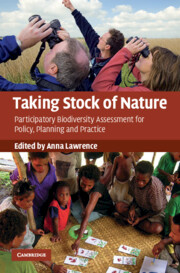Book contents
- Frontmatter
- Contents
- List of contributors
- Acknowledgements
- 1 Introduction: learning from experiences of participatory biodiversity assessment
- 2 Monitoring and assessment of biodiversity under the Convention on Biological Diversity and other international agreements
- 3 The Millennium Ecosystem Assessment: a multi-scale assessment for global stakeholders
- 4 Conservation of biological diversity in El Salvador shade coffee: the importance of taxonomic capacity for participatory assessments
- 5 Taking stock of nature in species-rich but economically poor areas: an emerging discipline of locally based monitoring
- 6 Researching local perspectives on biodiversity in tropical landscapes: lessons from ten case studies
- 7 Participatory resources monitoring in SW China: lessons after five years
- 8 Forest inventory in Nepal – technical power or social empowerment?
- 9 Perceptions of landscape change in British Columbia's Northwest: implications for biodiversity and participatory management
- 10 How thousands planned for a billion: lessons from India on decentralized, participatory planning
- 11 Inside monitoring: a comparison of bird monitoring groups in Slovenia and the United Kingdom
- 12 The personal and political of volunteers' data: towards a national biodiversity database for the UK
- 13 Improving forest management through participatory monitoring: a comparative case study of four community-based forestry organizations in the Western United States
- Index
- References
12 - The personal and political of volunteers' data: towards a national biodiversity database for the UK
Published online by Cambridge University Press: 06 December 2010
- Frontmatter
- Contents
- List of contributors
- Acknowledgements
- 1 Introduction: learning from experiences of participatory biodiversity assessment
- 2 Monitoring and assessment of biodiversity under the Convention on Biological Diversity and other international agreements
- 3 The Millennium Ecosystem Assessment: a multi-scale assessment for global stakeholders
- 4 Conservation of biological diversity in El Salvador shade coffee: the importance of taxonomic capacity for participatory assessments
- 5 Taking stock of nature in species-rich but economically poor areas: an emerging discipline of locally based monitoring
- 6 Researching local perspectives on biodiversity in tropical landscapes: lessons from ten case studies
- 7 Participatory resources monitoring in SW China: lessons after five years
- 8 Forest inventory in Nepal – technical power or social empowerment?
- 9 Perceptions of landscape change in British Columbia's Northwest: implications for biodiversity and participatory management
- 10 How thousands planned for a billion: lessons from India on decentralized, participatory planning
- 11 Inside monitoring: a comparison of bird monitoring groups in Slovenia and the United Kingdom
- 12 The personal and political of volunteers' data: towards a national biodiversity database for the UK
- 13 Improving forest management through participatory monitoring: a comparative case study of four community-based forestry organizations in the Western United States
- Index
- References
Summary
Britain has an exceptional tradition of natural history societies and amateur naturalists who collect data about species distributions, frequency and behaviour (Bell et al., this volume). This chapter examines an attempt to harness the data for a wider range of purposes, and the ways in which different actors have perceived and responded to this. Many of the volunteers have a strong personal attachment to their data, and to the ways in which they hope that it will be used. When powerful organizations become involved in managing the data, the volunteers can perceive threats and opportunities for the value of their data. The chapter considers the need to balance these emotional and political aspects in developing an effective national data management system. It is based on a cross-cutting analysis of research into the processes behind biodiversity action plans and biological recording, conducted over several years in the UK (Gillett and Lawrence, 2003; Lawrence, 2005; Lawrence, 2006; Lawrence and Molteno in press; Lawrence and Turnhout, 2005). The chapter draws on interviews with volunteers and professionals involved in the complex organizational landscape that has evolved around biological data collection and sharing, descriptions of the process on websites and in reports, and on presentations made at the annual National Biodiversity Network conferences.
The supply side: growth of biological recording
Biological recording, or the collection of data about the distribution and abundance of species, has a long history in Britain, going back to the leisure time of country vicars in the eighteenth century (Moss, 2004).
- Type
- Chapter
- Information
- Taking Stock of NatureParticipatory Biodiversity Assessment for Policy, Planning and Practice, pp. 251 - 265Publisher: Cambridge University PressPrint publication year: 2010
References
- 3
- Cited by

